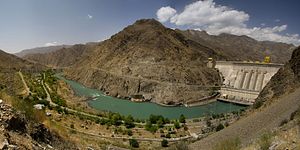Kyrgyzstan’s Deputy Minister of Energy Taalaibek Baygaziev has once again called for consumers to be mindful of their electricity usage as water levels in the Toktogul reservoir drop.
In a March 4 press conference, Baygaziev warned that the Toktogul reservoir – which supplies hydropower stations that provide around 40 percent of Kyrgyzstan’s electricity – is approaching dangerously low levels.
Toktogul’s capacity is 19.5 billion cubic meters (bcm) of water. It is considered “dead” at a level somewhere between 6.5 and 5.5 bcm – that is, when there is too little water to turn the turbines and produce electricity.
24.kg reported in early March that the water level at Toktogul was falling rapidly, comparing the first two months of 2024 to the previous year’s levels. For example, on February 1, 2023 there was 9.35 bcm in the reservoir and a year later that measure was 9.25 bcm. On average, the reservoir lost 45.7 million cubic meters each day in February. 24.kg forecasted that if the present pace of water loss continues, the “dead” mark may be reached sometime in April.
The report noted circumstances that affected both water usage and inflows into the reservoir, namely the accident at the Bishkek thermal power plant in early February and low temperatures that have kept water locked up in snowpack. In his March 4 press conference Baygaziev noted that after the accident at the Bishkek power plant some residents of the Kyrgyz capital switched to electrical appliances for heat, increasing consumption.
24.kg, which is under pressure from the state, also reported on public complaints about recent waves of blackouts. Energy officials say the outages are the result of equipment overload; customers are less convinced, with some telling 24.kg that the outages come at specific times, day after day.
In the March 4 press conference, Baygaziev urged people to limit electricity usage during peak demand times in the morning and in the evening. He noted that daily electricity consumption had recently increased to 69-70 million kilowatt-hours per day and that it needed to drop to 54 million kilowatt-hours or risk the reservoir’s operations.
He also noted that two units at Kyrgyz hydropower plants – one at Toktogul and another at Uch-Korgon – will be taken offline for repairs. He said that the current capacity of the country’s power plants would decrease by 290 MW while rehabilitation work was underway. The two projects, financed by the Asian Development Bank (ADB), are scheduled for competition in November and December 2024.
In December 2023, the energy ministry called on Kyrgyzstanis to conserve energy by using energy efficient light bulbs and unplugging electrical appliances when not in use. At the time, the Toktogul reservoir’s level was around 11.5 bcm, 1.2 bcm less than in 2022. Deputy Minister of Energy Atabek Abylgaziev told RFE/RL’s Kyrgyz Service, Radio Azattyk, that “citizens should not worry” about power outages.
In the same report, Kyrgyz energy expert Rasul Umbetaliev warned that “By April 1, 2024, 6.5 billion cubic meters of water may remain in the Toktogul reservoir. And such a low level is dangerous because at 6 billion cubic meters, water will stop reaching the units and the hydroelectric power station may stop.”
In August 2023, Kyrgyz authorities declared a three-year energy emergency to “bring the Kyrgyz Republic out of the energy crisis associated with climate challenges, low water inflow in the Naryn River basin, [and a] lack of generating capacity in the face of rapidly outstripping growth in energy consumption.” The ministry tried to moderate the declaration by saying that there was no immediate emergency but that urgent action needed to be taken and that the declaration would help clear bureaucratic hurdles.

































